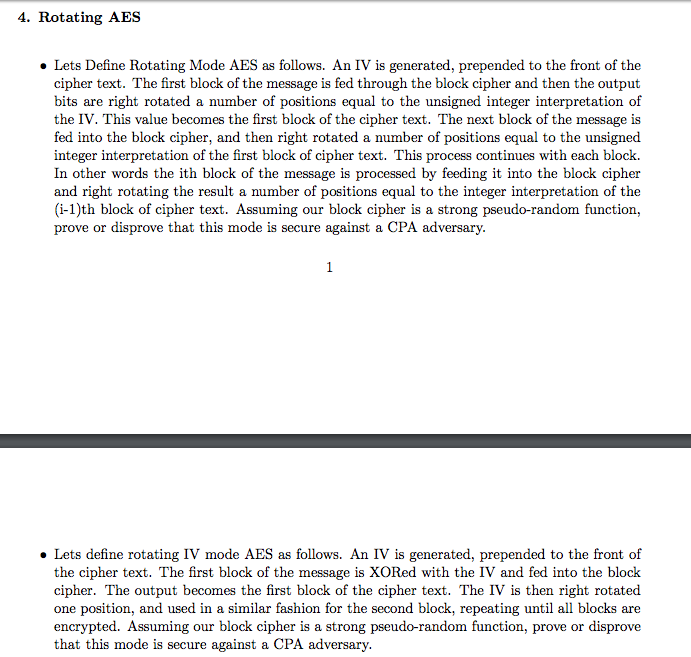
Lets Define Rotating Mode AES as follows. An IV is generated, prepended to the front of the cipher text. The first block of the message is fed through the block cipher and then the output bits are right rotated a number of positions equal to the unsigned integer interpretation of the IV. This value becomes the first block of the cipher text. The next block of the message is fed into the block cipher, and then right rotated a number of positions equal to the unsigned integer interpretation of the first block of cipher text. This process continues with each block. In other words the ith block of the message is processed by feeding it into the block cipher and right rotating the result a number of positions equal to the integer interpretation of the (i-l)th block of cipher text. Assuming our block cipher is a strong pseudo-random function, prove or disprove that this mode is secure against a CPA adversary. Lets define rotating IV mode AES as follows. An IV is generated, prepended to the front of the cipher text. The first block of the message is XORed with the IV and fed into the block cipher. The output becomes the first block of the cipher text. The IV is then right rotated one position, and used in a similar fashion for the second block, repeating until all blocks are encrypted. Assuming our block cipher is a strong pseudo-random function, prove or disprove that this mode is secure against a CPA adversary. Lets Define Rotating Mode AES as follows. An IV is generated, prepended to the front of the cipher text. The first block of the message is fed through the block cipher and then the output bits are right rotated a number of positions equal to the unsigned integer interpretation of the IV. This value becomes the first block of the cipher text. The next block of the message is fed into the block cipher, and then right rotated a number of positions equal to the unsigned integer interpretation of the first block of cipher text. This process continues with each block. In other words the ith block of the message is processed by feeding it into the block cipher and right rotating the result a number of positions equal to the integer interpretation of the (i-l)th block of cipher text. Assuming our block cipher is a strong pseudo-random function, prove or disprove that this mode is secure against a CPA adversary. Lets define rotating IV mode AES as follows. An IV is generated, prepended to the front of the cipher text. The first block of the message is XORed with the IV and fed into the block cipher. The output becomes the first block of the cipher text. The IV is then right rotated one position, and used in a similar fashion for the second block, repeating until all blocks are encrypted. Assuming our block cipher is a strong pseudo-random function, prove or disprove that this mode is secure against a CPA adversary







